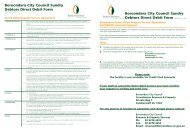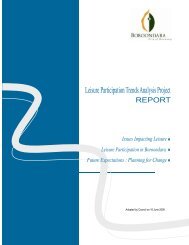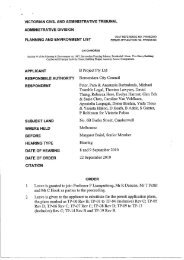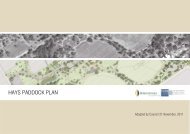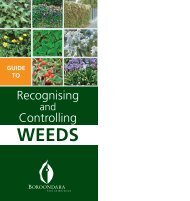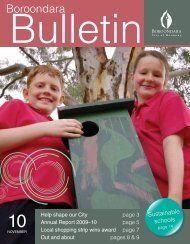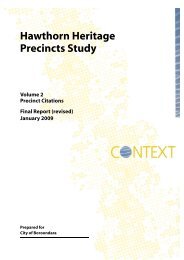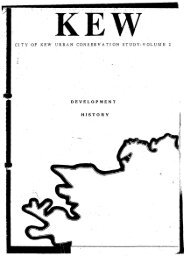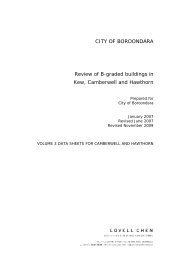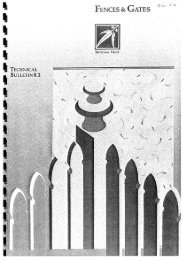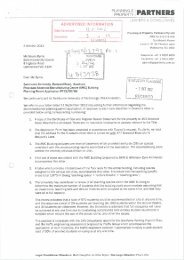Camberwell Conservation Study 1991 Vol 3 - City of Boroondara
Camberwell Conservation Study 1991 Vol 3 - City of Boroondara
Camberwell Conservation Study 1991 Vol 3 - City of Boroondara
Create successful ePaper yourself
Turn your PDF publications into a flip-book with our unique Google optimized e-Paper software.
7. Public perceptions<br />
<strong>Camberwell</strong> residents always shared in a self-image <strong>of</strong><br />
their municipality as a superior residential district and<br />
this is reflected in local planning decisions and in the<br />
appearance <strong>of</strong> streets and houses. The image was one<br />
<strong>of</strong>theperfect suburband local planningschemes, as well<br />
as the activities <strong>of</strong>resident action groups, alwayssought<br />
to preserve the suburban qualities <strong>of</strong> the suburb; by<br />
excluding industry and other dangerous or dirty activities<br />
and emphasizing thegarden and naturalelements<strong>of</strong><br />
the townscape.<br />
8. SocIal and political activity<br />
These images were acted upon by various social and<br />
political groups; in particular, local progress associations<br />
and then in broader exclusionist campaigns; i.e.,<br />
the campaign to exclude close hotels and keep the suburb<br />
'dry.' As a result <strong>of</strong> these campaigns <strong>Camberwell</strong><br />
has many public amenities not present in othersuburbs,<br />
varying from the elaborate street lamps and bus shelters<br />
to public parks and infant welfare centres. <strong>Camberwell</strong><br />
residents successfully fought to exclude large-scale flat<br />
development, polluting industries and, in their most<br />
celebrated campaign, they were able to keep liquor<br />
retailers out <strong>of</strong> their municipality. This exclusive character<br />
is today one <strong>of</strong> the central identifying features <strong>of</strong><br />
<strong>Camberwell</strong>.<br />
9. Landmarks<br />
The hills <strong>of</strong> <strong>Camberwell</strong> are crowned by prominent and<br />
familiar buildings, many <strong>of</strong>which have over time become<br />
local landmarks. The most common <strong>of</strong> these are<br />
churches and until recently these were the only<br />
<strong>Camberwell</strong> buildings visible from a great distance.<br />
Other landmarks, important for their local associations<br />
rather than for architectural style, include the<br />
<strong>Camberwell</strong> Town Hall building and the distinctive formation<br />
<strong>of</strong> the <strong>Camberwell</strong> station.<br />
10. Significant people<br />
As in other suburbs, <strong>Camberwell</strong> had a leading group<br />
involved in local, political and commercial activity.<br />
These were <strong>of</strong>ten councillors or builders or local church<br />
leaders and many took an active role in management<br />
committees for parks and gardens, or sat orwere prominent<br />
fignres in church groups and social clubs like boy<br />
scouts, girl guides or in local sporting clubs. Their<br />
private houses, as well as the public buildings in which<br />
they were involved, are reminders <strong>of</strong> their historical<br />
importance to the suburb.<br />
Area Identification<br />
VISualidentification methodology included assessment<br />
<strong>of</strong> the period expression <strong>of</strong> building groups where the<br />
amalgamation <strong>of</strong>for example houses from oneconfined<br />
period or development era givessuch a strong feeling <strong>of</strong><br />
place that this is akin to enteringa single buildingorsite<br />
which is exactlyas it was when it was created. The integ-<br />
<strong>Camberwell</strong> <strong>Conservation</strong> <strong>Study</strong> <strong>1991</strong> - Significant Areas<br />
rity <strong>of</strong> the street or area to a particular perceptible era<br />
was considered an important factor in physical identification.<br />
In <strong>Camberwell</strong>the period between the twoworld<br />
wars was an important growth era, although containing<br />
different architectural styles. Hence both the combination<br />
<strong>of</strong>styles representing a particularera (ie. Bungalow<br />
style houses, Mediterranean villa I and Old English<br />
styles) and the concentration <strong>of</strong> particular styles within<br />
that era, were noted as important factors in expressing<br />
both the social and architectural development <strong>of</strong><br />
<strong>Camberwell</strong>.<br />
Alternatively the precinct may contain examples from<br />
differing periods which have a high architectural integrity<br />
or significance. In this way the precinct may show<br />
clearly patterns <strong>of</strong>development in the city ora catalogue<br />
<strong>of</strong> individually important architecture from different<br />
eras(ie. Mont Albert Road).<br />
For continuity, this has been assessed in a similar manner<br />
to that for <strong>Study</strong> Area One (1985-6) where overlay<br />
maps showed concentrations <strong>of</strong>period(s) and individual<br />
site significance, thus isolating the above two main factors<br />
in area identification. Other overlays might illustrate<br />
historical themes, such as important transport<br />
routes oruse concentrations. The residentialestatesalso<br />
create another form <strong>of</strong> overlay but these boundaries<br />
were not necessarily adhered to in conservation area<br />
delineation unless the built physical expression also<br />
existed for the era when the estate wascreated. Based on<br />
the findings <strong>of</strong> this process, areas <strong>of</strong> architectural or<br />
historical significance have been demarcated and<br />
defined.<br />
Toachieve this process efficiently, this study included an<br />
initial general identification stage which isolated architecturally<br />
representative areas for further study using<br />
the above mapping techniquesf. These were combined<br />
with areas recommended from the Environmental History<br />
such as the Ashburton Housing Commission<br />
Estate 3. What follows, under Precinct Citations, is the<br />
significance statement which isolates the historical or<br />
architectural worth <strong>of</strong> each identified area.<br />
This is augmented by the Site Schedule which lists all<br />
contributory sites within precincts; their contribution<br />
being based on the collective character<strong>of</strong>other componentsites<br />
as described in theprecinct citation. For example<br />
ifthe precinct was considered important because <strong>of</strong><br />
its representation <strong>of</strong>large to medium sized houses from<br />
the late 19305early 19405 (ie. precinct 1), houses from<br />
this era are scheduled as contributory. However houses<br />
which are inside the precinct boundaries but are from<br />
outside<strong>of</strong>thesignificant date range are only listed ifthey<br />
are individually significant (value A-C).<br />
Precinct Importance Evaluation<br />
The area's expression <strong>of</strong> an important development<br />
era(s), historical themets) or creative period(s) is paramount.<br />
Thisexpression typicallyresults from an amalgamation<br />
<strong>of</strong> parts (ie. individual houses in a streetscape<br />
1 IncludingSpanish and Italian provincial influences<br />
2 <strong>Camberwell</strong> <strong>City</strong>'s computer property data base was utilized for accurate dating <strong>of</strong> sites from the 19305on<br />
3 precinct 42<br />
3-3



